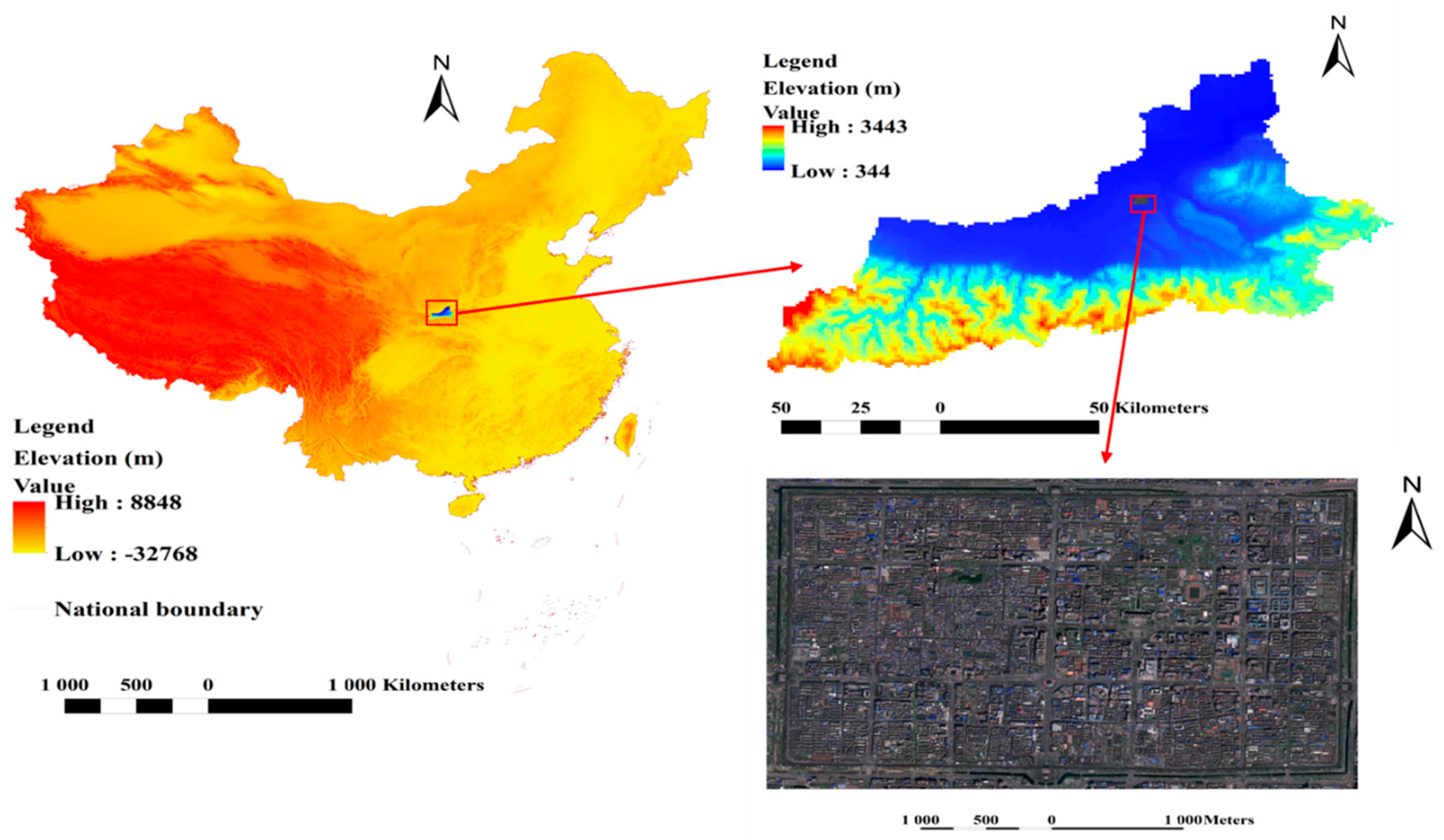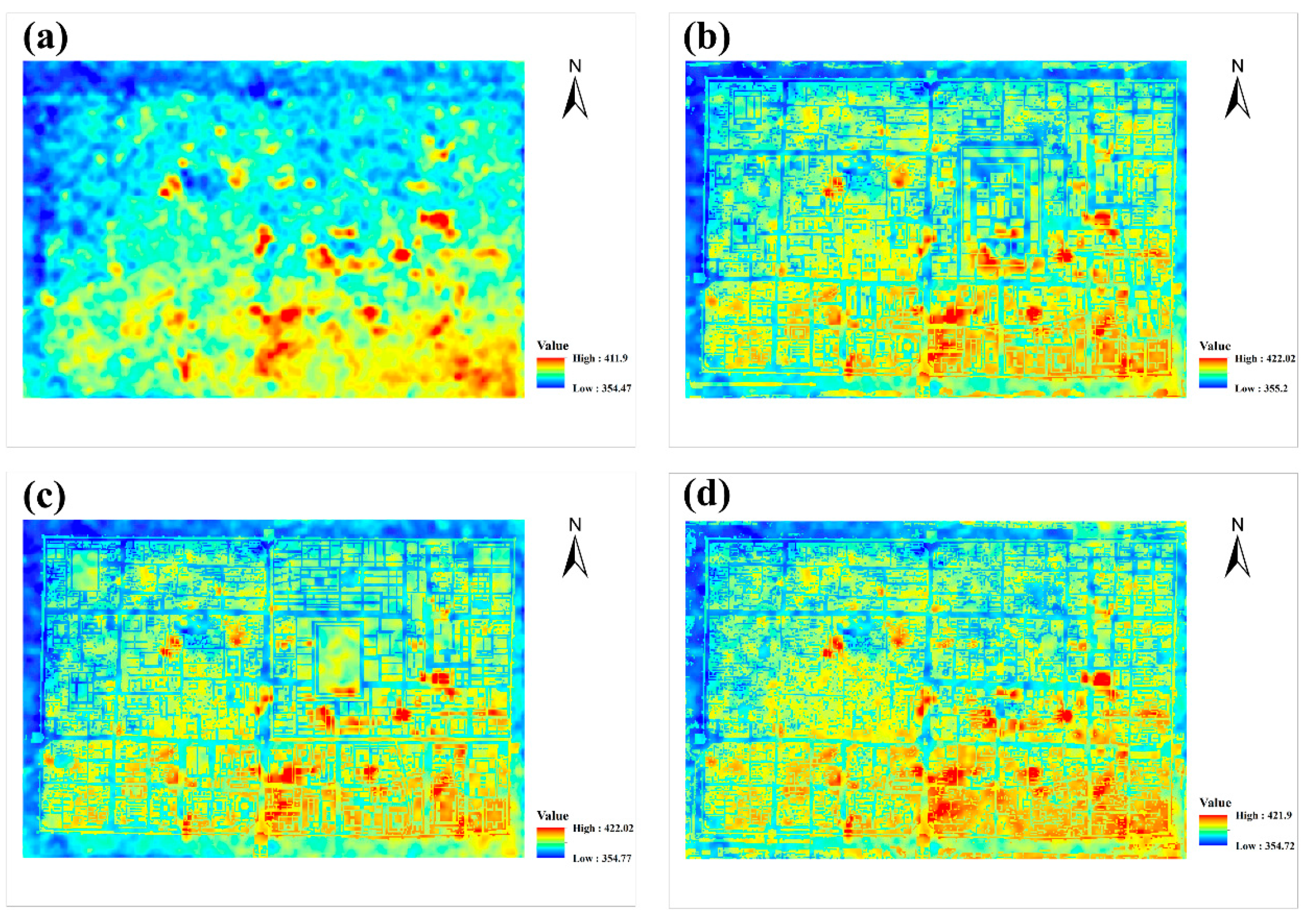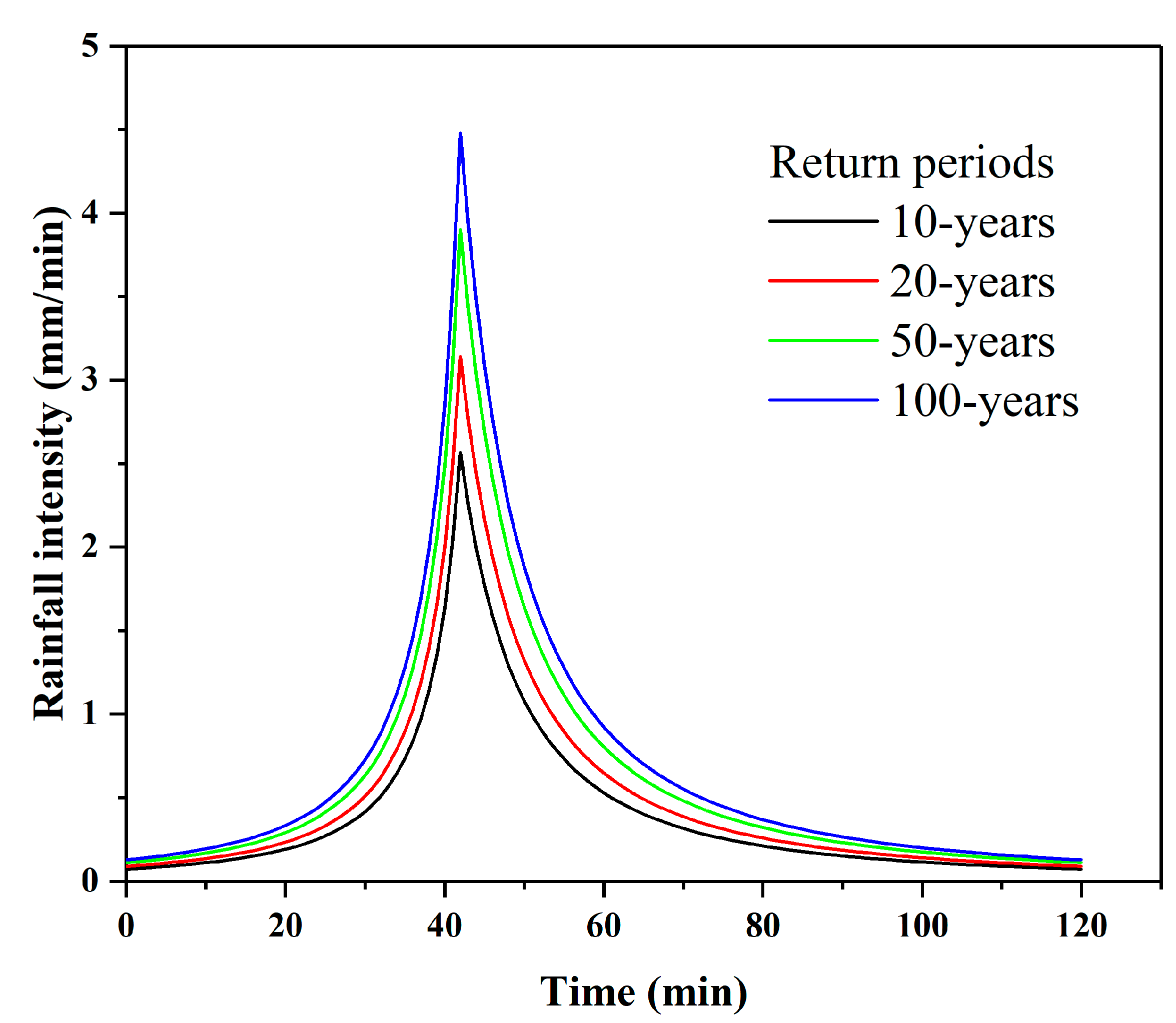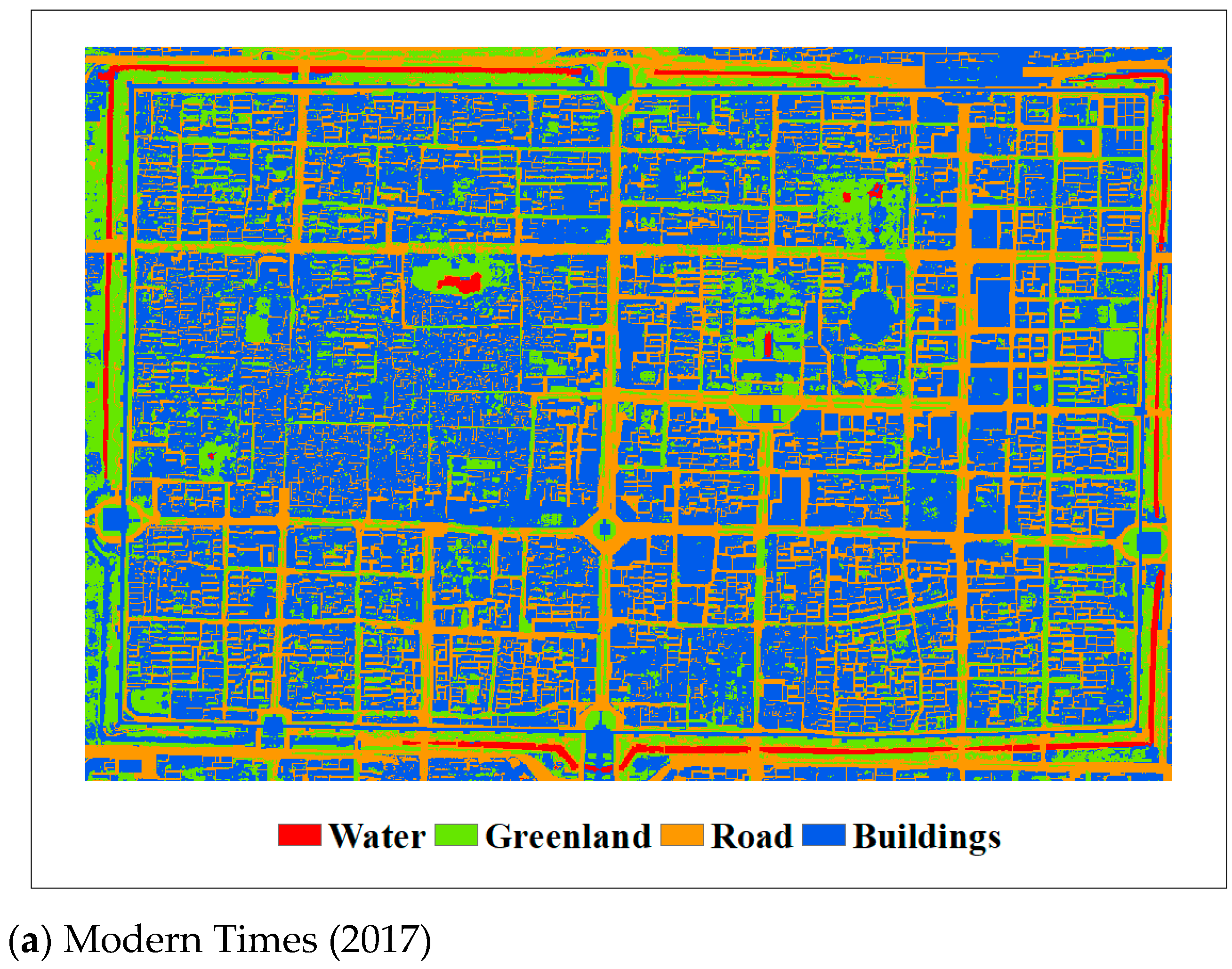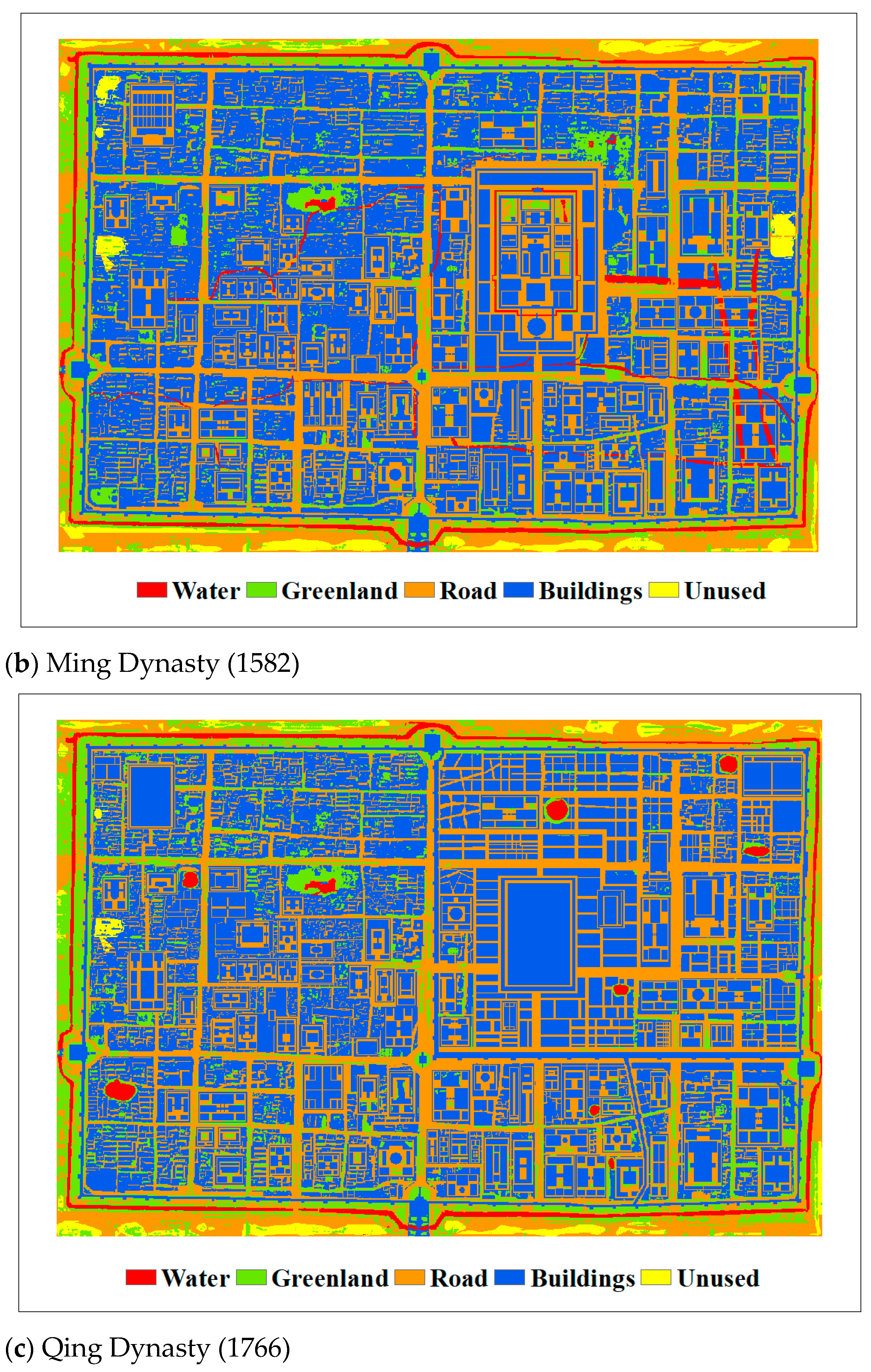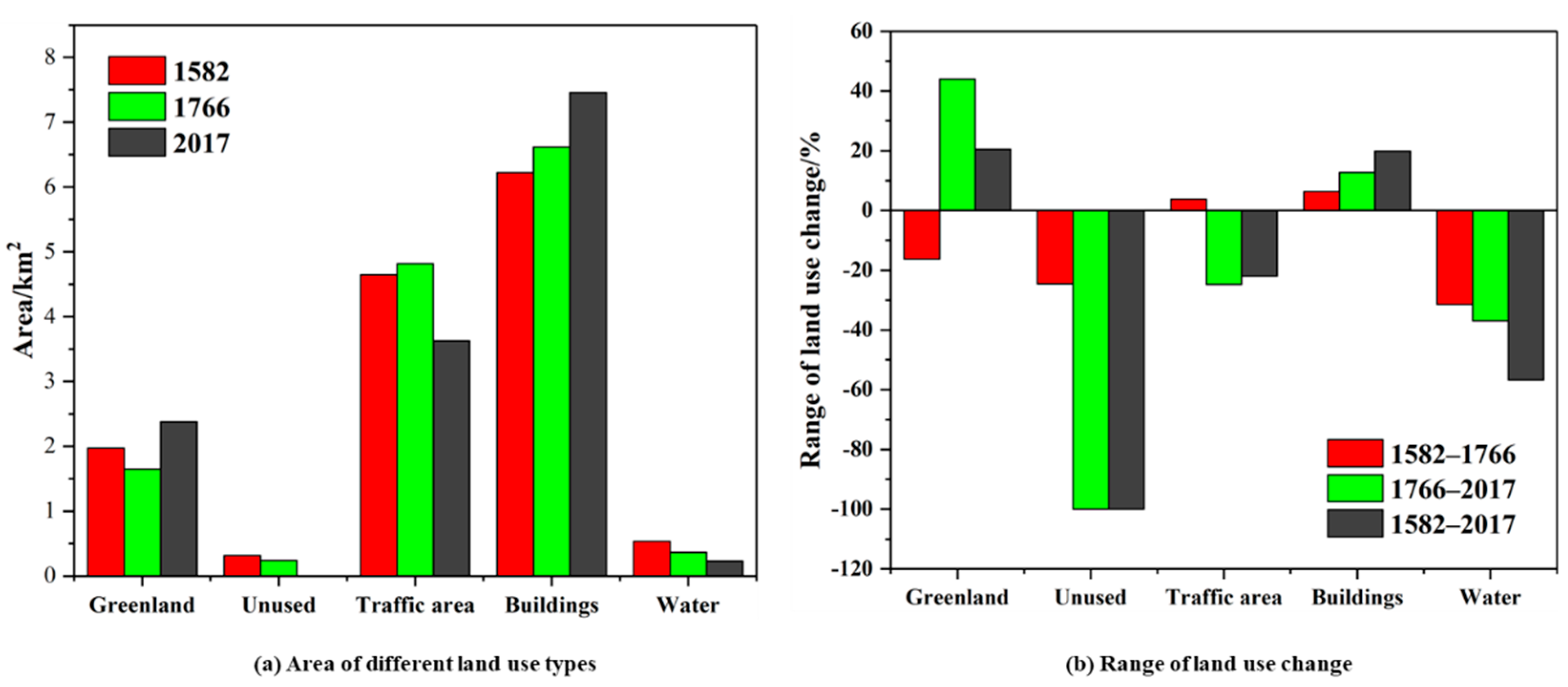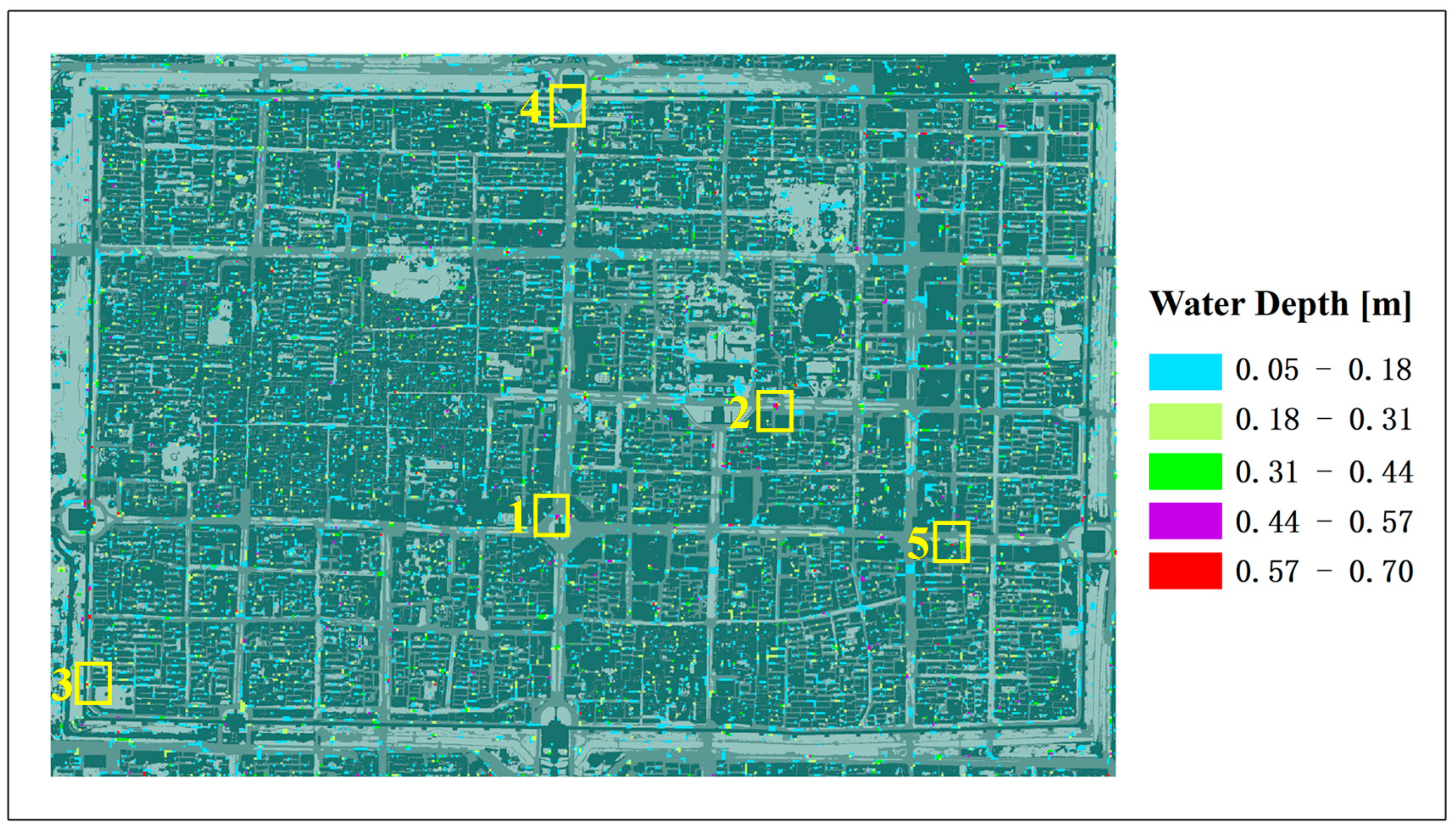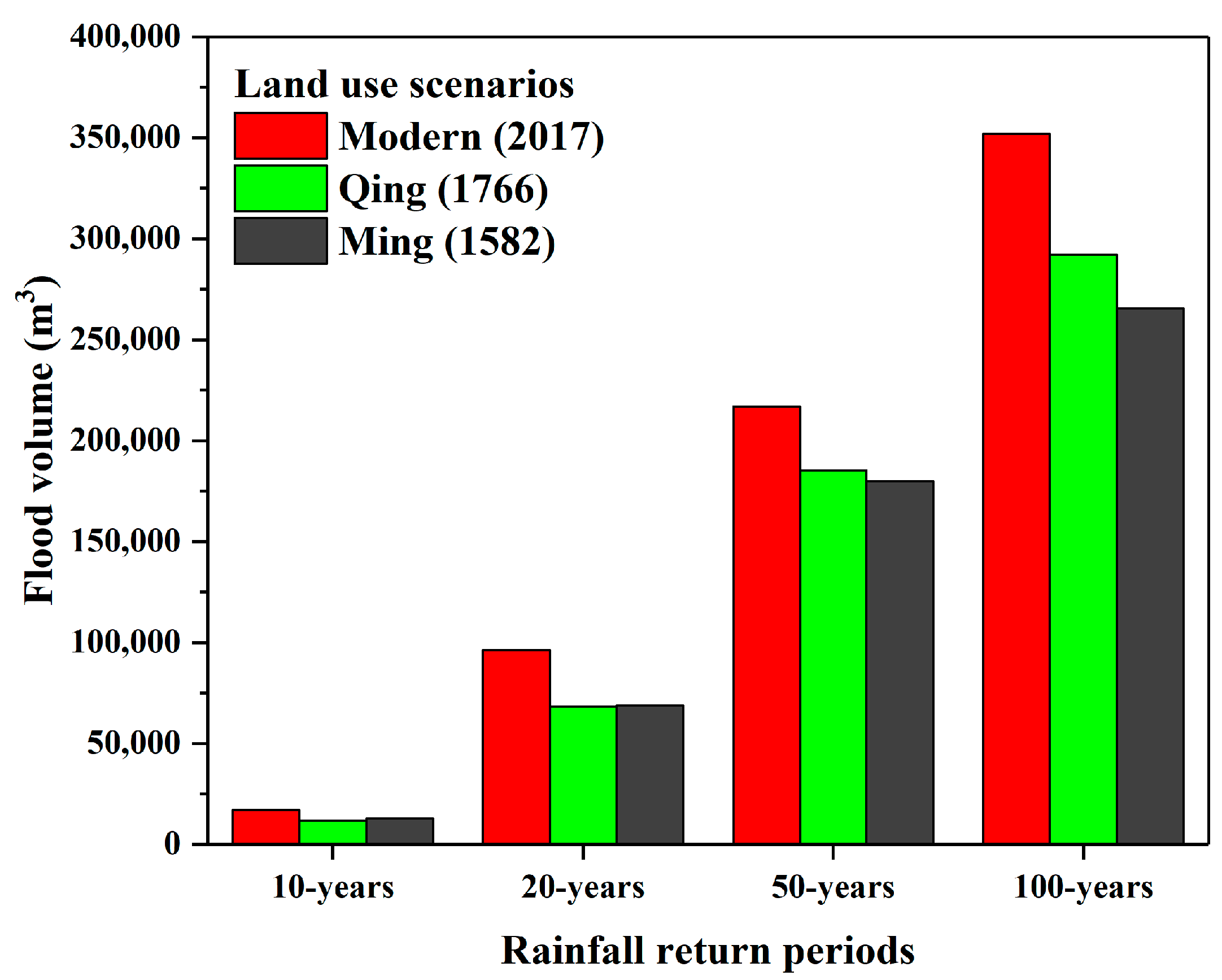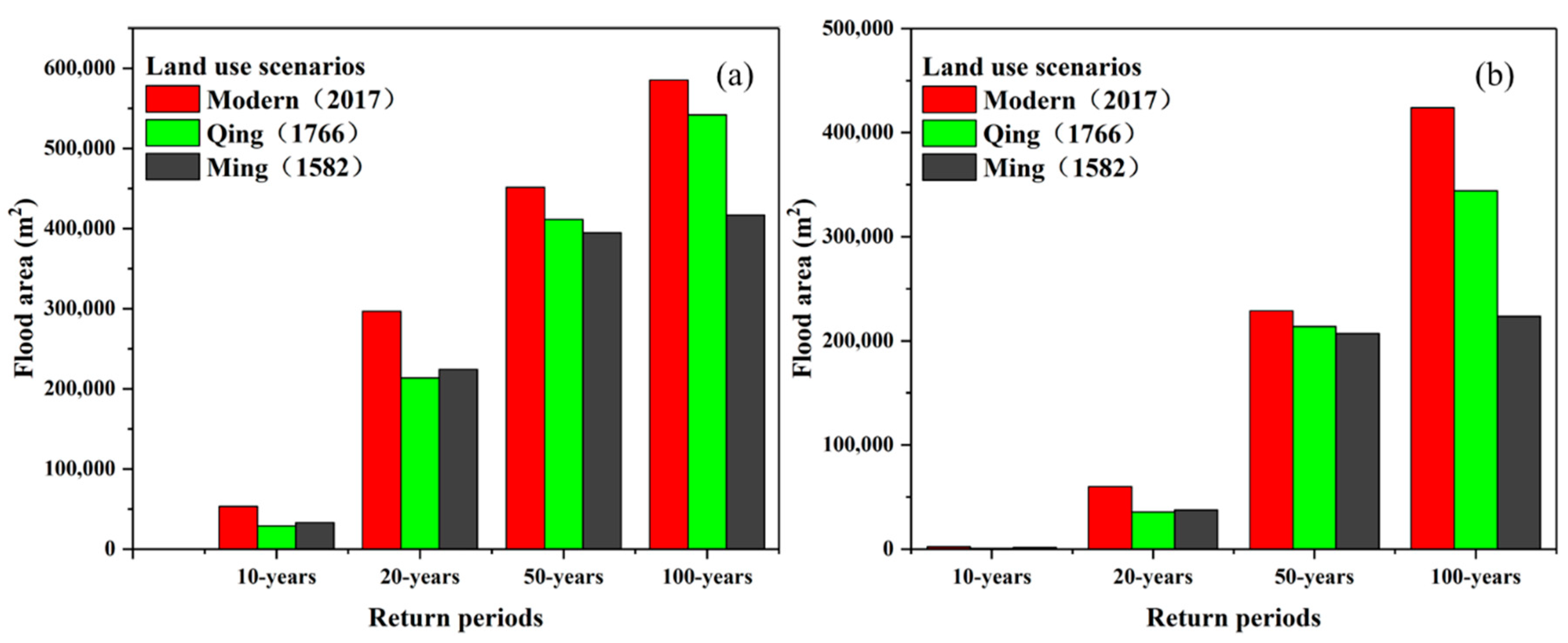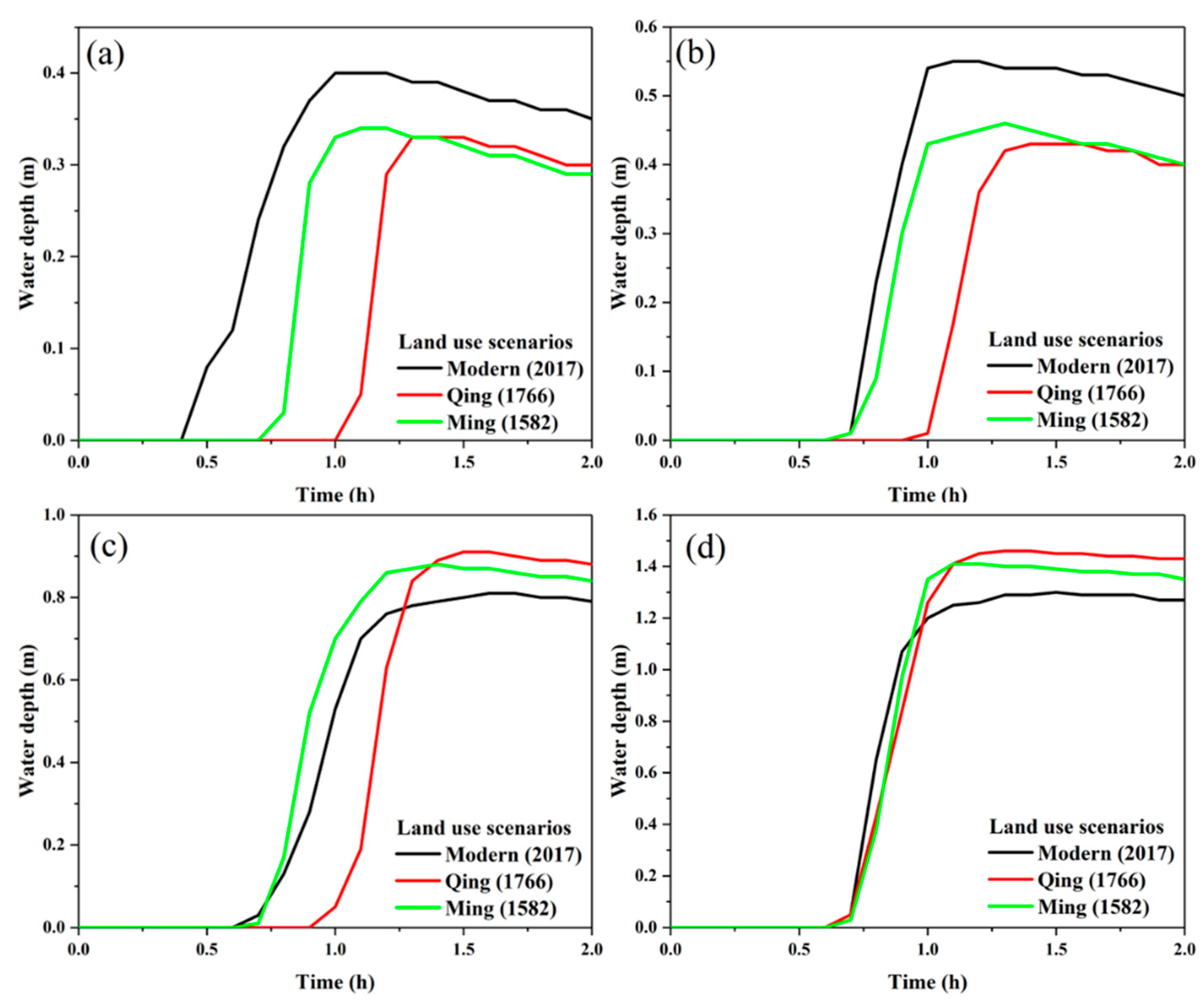1. Introduction
Human-caused land use/cover change (LUCC) is one of the key indicators of surface environmental change, which has a significant influence on long-term environmental sustainability [
1,
2]. Common effects of land-use change include clearing of natural vegetation, disruption of carbon sinks, loss of biodiversity, changes to hydrology, and impacts on climate [
3,
4,
5,
6,
7]. Therefore, it is necessary to comprehend the patterns, causes, and effects of land-use change in order to find solutions for land-use sustainability [
8]. Historical LUCC is crucial for identifying the mechanism of climate change, defining the environmental consequences of LUCC across long time scales, and understanding present and future land-use and cover-change processes [
9,
10]. Since the 1990s, the International Geosphere-Biosphere Programme (IGBP) and International Human Dimensions Programme on Global Environmental Change (IHDP) have taken the understanding of LUCC in the past (especially in the past 300 years) as one of the key points of its core program [
11,
12,
13]. Consequently, research on LUCC in historical periods has attracted extensive attention worldwide.
Long-term (decadal–centennial) land-use change history research can offer unique insights into the intricate linkages between societal and environmental processes in land systems [
14]. Reconstructed historical land uses are critical data for assessing general historical processes and trends in human activities at global/regional scales, as well as for assessing long-term impacts on biodiversity, biogeochemistry, geomorphic processes, and climate systems [
15,
16,
17]. Globally, land-use reconstruction depends on inverse modeling, which integrates dynamic changes in human-environment connections spanning hundreds or thousands of years [
18,
19,
20,
21,
22]. Regional historical reconstruction is based on archives, inverse modeling, or a mix of data and models [
23,
24]. Sohl et al. [
25] used a wide range of historical data sources and a spatially explicit modeling framework to simulate the spatially explicit historical LUCC of the mainland United States from 1938 to 1992, and the results obtained were broadly consistent with the temporal and spatial change trends of land use in historical data sources. Meiyappan et al. [
26] proposed an implicit method to improve the consistency between the historical land-cover situation and actual remote sensing observations and used three widely recognized historical land-use estimates, combined with common urban land datasets, to generate three different estimates of historical land-cover change and potential LUCC conversion. Fang et al. [
27] proposed a methodological framework for assessing the credibility of global land-cover datasets and studied five cases, such as the amount of historical cultivated land in Germany in the past 1000 years and the spatial distribution accuracy of cultivated land-cover in the North China Plain in the past 300 years, to evaluate the credibility of historical cultivated land-cover data. Luo et al. [
28] developed a new method to estimate historical land use, reconstructing historical land use in the Kamo River Basin (KRB) in Japan in 1843, 1902, and 1927. This approach produces a set of basic rules by comparing existing land uses with historical documents, allowing users to quickly reconstruct historical land uses using historical information.
LUCC is an important element determining regional hydrological features, and its modification causes changes in water distribution patterns and hydrological processes such as evaporation, runoff, lateral flow, infiltration, and groundwater recharge [
29,
30]. Since the middle of the 20th century, several studies have been carried out to determine how LUCC patterns affect hydrological processes [
31,
32,
33]. Studies on the connection between variations in plant cover and water runoff dynamics offer knowledge for managing water resources and successfully mitigating the harm brought on by land-use changes [
34,
35,
36,
37]. Glavan et al. [
38] used the existing digital map of historical land use in a small watershed (Raka River) in Slovenia to compare with the land-use situation in the same study area in 2009, and simulated the impact of historical land use on water quality through a SWAT watershed model.
Land use/cover in the historical period is the precursor and basis of modern land use/cover. The study of land use/cover change in the historical period can not only explore how ancient people transformed the original living environment to adapt to the rapidly developing society, but also guide current urban land use. The objects of this study are: (1) to reconstruct the ancient land-use map of the study area by collecting historical documents and analyzing the changes in land use in different periods; (2) to simulate flooding in the study area under modern and ancient land-use scenarios; (3) analyze the relationship between land-use change and urban flooding.
2. Materials and Methods
2.1. Study Area
Xi’an City is located in the Guanzhong Basin in the middle of the Weihe River Basin, between 107.40°–109.49°E and 33.42°–34.45°N, with an annual average temperature of 13.4 °C and annual precipitation of 621 mm. It is an important central city in western China and an important national scientific research, education, and industrial base.
In this paper, the area of Xi’an within the Ming-era city wall was selected as the study area to study land-use change. The total area of the study area is 13.69 km
2, as shown in
Figure 1.
2.2. Modern Land Use Data
The remote sensing image data for this study come from the Resource and Environmental Science and Data Center of the Chinese Academy of Sciences (
https://www.resdc.cn (accessed on 5 December 2020)). The data were collected on 12 April 2017. The spatial resolution of the full-color image is 0.8 m, the spatial resolution of the PMS1 sensor multispectral image is 3.2 m, and the image size is 25 km × 25 km.
In this study, the Classification and Regression Tree (CART) method proposed by Grajski et al. [
39] was used to extract land-use data based on remote sensing images.
2.3. Paleo Land Use Reconstruction
The Paleo-Land-Use Reconstruction (PLUR) program is a Fortran-based algorithm for combining two raster data files [
28]. It aims to reconstruct the historical land use of the target area based on historical information (historical social structure, historical environment, historical ancient books, historical maps, historical documents, etc.). The reconstruction of historical land use through PLUR requires 5 steps (
Figure 2), which are described in detail below:
(1) Collect historical information related to the study area, including land-use change records and social information.
(2) According to the completed information in step (1), delineate the area of land-use change and build it into vector data (features and polygons). The vector data delineation is a three-step process: (a) Geographically unchanged landmarks are used to match modern land use with ancient historical documentation. (b) Document areas of change based on past and present land use comparisons. (c) Draw the vector polygons of the land types of the ancient study area according to the information sorted out in the previous two steps.
(3) Make geometric corrections. Use a few basic rules to modify the shape of the vector data and compare it with modern digitized land-use data. In this step, we need to consider the history of urban construction from ancient times to modern times, and the new ancient study area land-use vector data is created after geometric correction. The basic rulemaking process is detailed as follows: (a) Collect historical books, paper maps, and modern digital land use data. (b) Using the results of step (a), we analyze digital land-use data and historical paper maps and consult historical books to identify detailed historical information such as the locations of temples, roads, rivers, and other landmarks. (c) Unchanged areas are used to synchronize historical and modern land use information.
(4) Convert the modern land-use vector data files and geometrically corrected ancient study area land-use vector data to raster data in ASCII file format. Provide the ASCII input files of modern land-use raster data and new vector data to the PLUR program.
(5) After step (4), the reconstructed historical land-use raster data is output from the PLUR program, giving details of each classification of the reconstructed historical land use.
2.4. DEM Generalization
Roads are prone to urban flooding, and buildings in cities can have a blocking effect on surface runoff. In order to simulate more realistic urban flooding, we modified the topographic data from the study area based on a modern DEM (
Figure 3a) with a resolution of 12.5 m. We subtracted 2 m from the elevation of the grid where a water body is located and 15 cm from the grid where a road is located and increased the elevation of the grid where a building site is located by 10 m. The topographic generalization results of the study area over the three periods are shown in
Figure 3b–d, respectively.
2.5. Flo-2D Model
Flo-2D is a two-dimensional finitely differential flood model based on a mesh system that simulates floods at high resolution [
40]. The two-dimensional flood calculus control equation of the model is as follows:
where
t is the time,
h is the depth of the water,
V is the velocity of the water flow in the
x direction,
g is the acceleration due to gravity,
i is the hydraulic slope,
Sf is the friction descent, and
S0 is the slope of the riverbed.
2.6. Infiltration Intensity and Manning Roughness
Based on the characteristics of the study area, the Horton infiltration method is selected in this paper. This method is suitable for the simplicity of the urban watershed, where runoff is not sensitive to soil parameters and there is a reasonable balance between the infiltration process. The Horton infiltration equation is:
where
f is the infiltration rate (mm/h) at time
t after rainfall begins,
fi is the initial infiltration rate (mm/h),
f0 is the stable infiltration rate (mm/h), and
A is the attenuation coefficient (h
−1). The parameter range of the Horton infiltration model can be obtained by referring to the FLO-2D model manual.
In this study, the impermeable surface (road, construction land) is not calculated as seepage, and the precipitation in the water area is completely infiltration. For the study area, the drainage capacity of the pipe network in the modern period (2017) is equivalent to an infiltration rate of 10.74 mm/h [
41]. That is, the part with rainfall intensity less than 10.74 mm/h will be discharged through the urban pipe network, and the part with rainfall intensity greater than 10.74 mm/h will form surface runoff.
The relevant infiltration parameters and Manning’s coefficient of urban unused land in the Ming and Qing Dynasties can be referred to the study of Hou et al. [
41], who set the infiltration rate as 19.43 mm/h and Manning’s coefficient as 0.03. Since the main roads in the study area were paved with blue slate in the Ming and Qing dynasties, the non-main roads were mostly natural dirt roads rather than impermeable surfaces. Therefore, referring to the soil types and related osmotic parameters recorded in the Ming and Qing Dynasties, the average infiltration rate of trunk and non-trunk roads was 13.5 mm/h, and the average Manning coefficient was 0.021.
The detail of the infiltration parameters and Manning’s coefficients are listed in
Table 1 and
Table 2, respectively.
2.7. Rainfall Data
Based on the Xi’an rainstorm formula and the Chicago rain type method, this study designed four kinds of rainstorm recurrence periods of 10 years, 20 years, 50 years, and 100 years, and the rainstorm lasted 2 h.
According to the literature [
42], the calculation formula for the intensity of heavy rain in Xi’an is:
where
q and
i both represent the intensity of the rainstorm, where the unit of
q is L⁄(h∙m
2) and the unit of
i is (mm⁄min);
p is the recurrence period; and
t is the period the heavy rain lasted.
The Chicago rain type method uses the peak ratio to express the ratio of the peak at present time to rainstorm time. According to the results of the study of Bi Xu et al. [
43], the value range of the peak ratio in Xi’an is 0.31731–0.49679. This study selected the peak ratio as 0.35. The design of the rainstorm is shown in
Figure 4. The designed rainstorm intensity of each return period was 25 mm/h (10-year return period), 30 mm/h (20-year return period), 38 mm/h (50-year return period), and 44 mm/h (100-year return period).
5. Conclusions
Based on the PLUR land use reconstruction program, this study reconstructs the land-use classification of the Ming and Qing dynasties within the Ming city wall of Xi’an. Then, the FLO-2D model was used to simulate urban flooding under four designed rainstorm conditions under different land-use scenarios. The main conclusions are as follows:
(1) Combined with the modern land-use situation in the study area, the urban construction land area showed a trend of increasing across the 435 years of the study, while the area of unused land and that of water bodies were continuously decreasing. By 2017, there was no unused land in the study area. Urbanization is the main factor leading to the change in land use within the Ming city wall of Xi’an.
(2) The flooding in the modern land-use scenario is the most serious. Under the four rainfall return periods, the flood volume and flooded area of the modern land-use scenarios are at a maximum.
(3) The increase in impervious area, the decrease in water bodies, and the increasing density of buildings are the main reasons for worsening urban flooding.
In the future flood control work in the study area, it is necessary to comprehensively consider increasing the proportion of permeable surface area, increasing urban water bodies, improving the design standard of the underground drainage network, and determining the most suitable flood control policy to deal with urban flooding.
